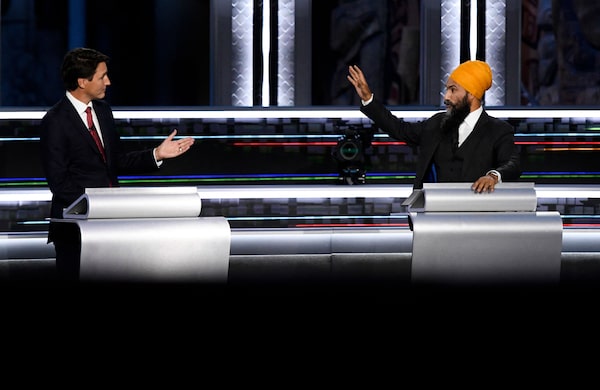
Prime Minister Justin Trudeau says a deal has been struck with the NDP to prop up the minority Liberal government until 2025 in exchange for parliamentary co-operation and progress on key NDP policies.JUSTIN TANG/AFP/Getty Images
Lori Turnbull is the director and an associate professor at the School of Public Administration at Dalhousie University.
The Liberals and the New Democrats have struck an agreement of confidence and supply, saying that it’s in the pursuit of stability to Canadians, as well as ambitious and expensive social policy initiatives like dental care and national pharmaceutical coverage. The arrangement – which is set to last until Parliament rises in June, 2025, but could be ended at any time – is entirely legitimate in a parliamentary system and, in an increasingly uncertain world, might well be a welcome injection of predictability for some voters.
But let’s cut through the rhetoric: This is about politics, not policy – nor is it about stability, either. This deal does not signal a substantive shift in the relationship between the Liberals and the NDP, but is instead an explicit acknowledgment of their pre-existing partnership, which was stable to begin with.
Justin Trudeau announces pact with NDP to keep Liberals in power until 2025
Consider a similar agreement that was struck in 2017, between John Horgan’s New Democrats and Andrew Weaver’s Green Party in British Columbia. The provincial election delivered a very close result: Christy Clark’s incumbent Liberals won 43 seats, the NDP 41 and the Greens 3. The Liberals, who tried to form government with this mandate, were defeated immediately on a Speech from the Throne and, after the province’s lieutenant governor denied Ms. Clark’s request for dissolution, the government resigned. The second-place NDP was then asked to form government, which they did by establishing a single-seat majority in the legislature with the support of the Green Party. Their confidence-and-supply agreement served as proof to the public that the government would be viable and stable.
In contrast, the relationship between the federal Liberals and the NDP could be categorized as perhaps a bit too stable. There is little space between them on many matters of policy and, given their own desire to avoid an early election, the NDP seems more than happy to prop up the Trudeau government for as long as they need.
The Liberal/NDP agreement has clear political benefits for both parties involved. Prime Minister Justin Trudeau’s popularity has taken a serious hit over his handling of the trucker convoy, and the agreement could give his government a shot in the arm. It would tangibly prove that Mr. Trudeau has the confidence of the House and, therefore, can pass a budget in the spring, play a meaningful role in global security with respect to the war in Ukraine, and pursue a robust policy agenda in the years to come.
But the agreement also gives the government license to continue its dismissive attitude toward Parliament and its members, committees and processes. After all, who needs parliamentary scrutiny and approvals when the leaders have agreed to the important stuff already? The House of Commons will now become even more of a rubber stamp.
For the NDP, the arrangement gives them a track record of sorts. NDP Leader Jagmeet Singh can claim to have pushed the government to make progress on matters of vital importance to the base. Given that the party has received less than 20 per cent of the popular vote in the last three elections, it needs a shot in the arm of its own.
The Conservatives are the real “targets” of this deal. It takes the wind out of the sails of their ongoing leadership contest, their third since 2015. Front-runners Jean Charest and Pierre Poilievre have made clear that they are running to be the next Prime Minister of Canada, but the agreement signals that the job will not be vacant any time soon. Interim Conservative leader Candice Bergen has responded with inflammatory and misleading rhetoric, describing the deal as a form of “blackmail” and an exercise in “vote-buying” while calling the deal a “coalition,” which is just plain wrong, as there will be no NDP representation in cabinet.
The agreement may set out a vision for the next three-and-a-half years, there are still plenty of unknowns. Mr. Trudeau has said that he plans to run in the next election, but the deal – which was struck at the top – could also give both parties room to breathe in the event that either wants to find a new leader before the next election. The opposite could also be true: Mr. Singh could use the time to build up his brand, while giving Mr. Trudeau a full 10 years in the Prime Minister’s Office. And then there’s another scenario: that the Liberals or NDP could end the agreement early, as the NDP did in British Columbia in 2020, if the polls offer enough incentive to do so.
But what should hopefully be clear to the government – particularly after the results of 2021′s snap election – is that this is a promise it needs to keep with voters as much as with the NDP.
Keep your Opinions sharp and informed. Get the Opinion newsletter. Sign up today.